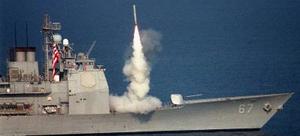Attack on LibyaAnalysis: More questions than answers
It is not clear, exactly, what targets have been attacked — and what is the overall goal of the campaign; Libya does not have an army the size of Iraq’s circa 2003, but an attack by 124 cruise missiles is on the limited side — and the numbers of planes involved is also on the small side; if what we know about the weekend air campaign is accurate, then there is not enough in it materially to weaken Gaddafi and his forces, nor is there anything in it to strengthen those who oppose him; we must conclude, then, that the campaign is more a part of a complex bargaining process with Gaddafi than a serious effort to topple him from power; it would be wise for NATO leaders to be clearer about the goal of the campaign against Gaddafi: democratic public opinion would demand it, and the Arab world, watching the West’s every move, should not be allowed to have unrealistic expectations about what it is we are trying to achieve

Tomahawks start clearing Libyan air defense // Source: seaforces.org
The weekend attacks on targets inside Libya raise more questions about NATO’s ultimate goal in the campaign.
Here is what we know about the attacks on Libya, based on reports by the BBC and Fox News: On the military front
- The United States fired 124 Tomahawk missiles onto strategic air defense systems across Libya.
- There were no reports of any allied planes being lost and no reports of civilian injury.
- A total of 15 U.S. Air Force and Marine Corps aircraft engaged Libya, including three B2 bombers. The bombers targeted pro-Qaddafi ground forces.
- The U.S. has at least eleven naval vessels in the Mediterranean, including three submarines, two destroyers, two amphibious warfare ships, and the USS Mount Whitney, a command-and-control vessel that is the flagship of the Navy’s 6th Fleet.
- Also in the area are Navy P-3 and EP-3 surveillance aircraft.
- Qatar is to send four planes to join the coalition enforcing the UN-mandated no-fly zone. The move would make Qatar the first Arab country to play an active part in the campaign against Col Gaddafi.
- Other Arab countries are also preparing to join the campaign against Col Gaddafi, Vice Adm. Bill Gortney, the director of the Joint Staff, said, adding that those governments would make their own announcements in due course.
- The build-up of forces to enforce the no-fly zone continues. The French aircraft carrier Charles de Gaulle has left the Mediterranean port of Toulon for Libya.
- Denmark and Norway are each sending six planes. Spain has sent at least three planes, plus a refuelling aircraft, while Italy also has jets ready to deploy.
- In a news conference on Sunday, a Libyan military spokesman said its armed forces had ordered a ceasefire across the entire country, beginning at 21:00 local time (19:00 GMT).
- Despite the announcement, the BBC correspondent says that pro-Gaddafi troops have tried to enter Benghazi and have been in action at Misrata.
- A rebel spokesman in Misrata told the BBC that pro-Gaddafi forces had launched fresh attacks on Sunday with heavy shelling.
On the political front
- The head of the Arab League, who supported the idea of a no-fly zone, has criticized the severity of the bombardment. “What is happening in Libya differs from the aim of imposing a no-fly zone, and what we want is the protection of civilians and not the bombardment of more civilians,” said Arab League Secretary General Amr Moussa. Arab League support was a key factor in getting UN Security Council backing for the resolution authorizing the move.
Questions
1. It is not clear, exactly, what targets have been attacked – and what is the overall goal of the campaign. Libya does not have an army the size of Iraq’s circa 2003, but an attack by 124 cruise missiles is on the limited side – and the numbers of planes involved is also on the small side.
2. This small-scale attack may – just may – disrupt Libyan air operations, but unless command, control, and communication facilities were destroyed as well, Gaddafi ’s ability to control his armed forces could not have been degraded by much.
3. Degrading Gaddafi’s capabilities is one thing, but unless the military capabilities – and training — of the anti-government rebels are augmented, they will not be a match to Gaddafi’s regular army, even if that army is shorn of its air assets.
4. The Sudanese campaign in Darfur demonstrated that men on camels need only AK-47s – and the Janjaweed were only AK-47-equipped men on camels — to kill a lot of people and terrorize even more. Unless Gaddafi’s regular units, and his tribal power base, are attacked, his ability to cause a lot of harms remains undiminished.
In short: If what we know about the weekend air campaign is accurate, then there is not enough in it materially to weaken Gaddafi and his forces, nor is there anything in it to strengthen those who oppose him.
The conclusion, then, must be that the campaign is more a part of a complex bargaining process with Gaddafi than a serious effort to topple him from power.
